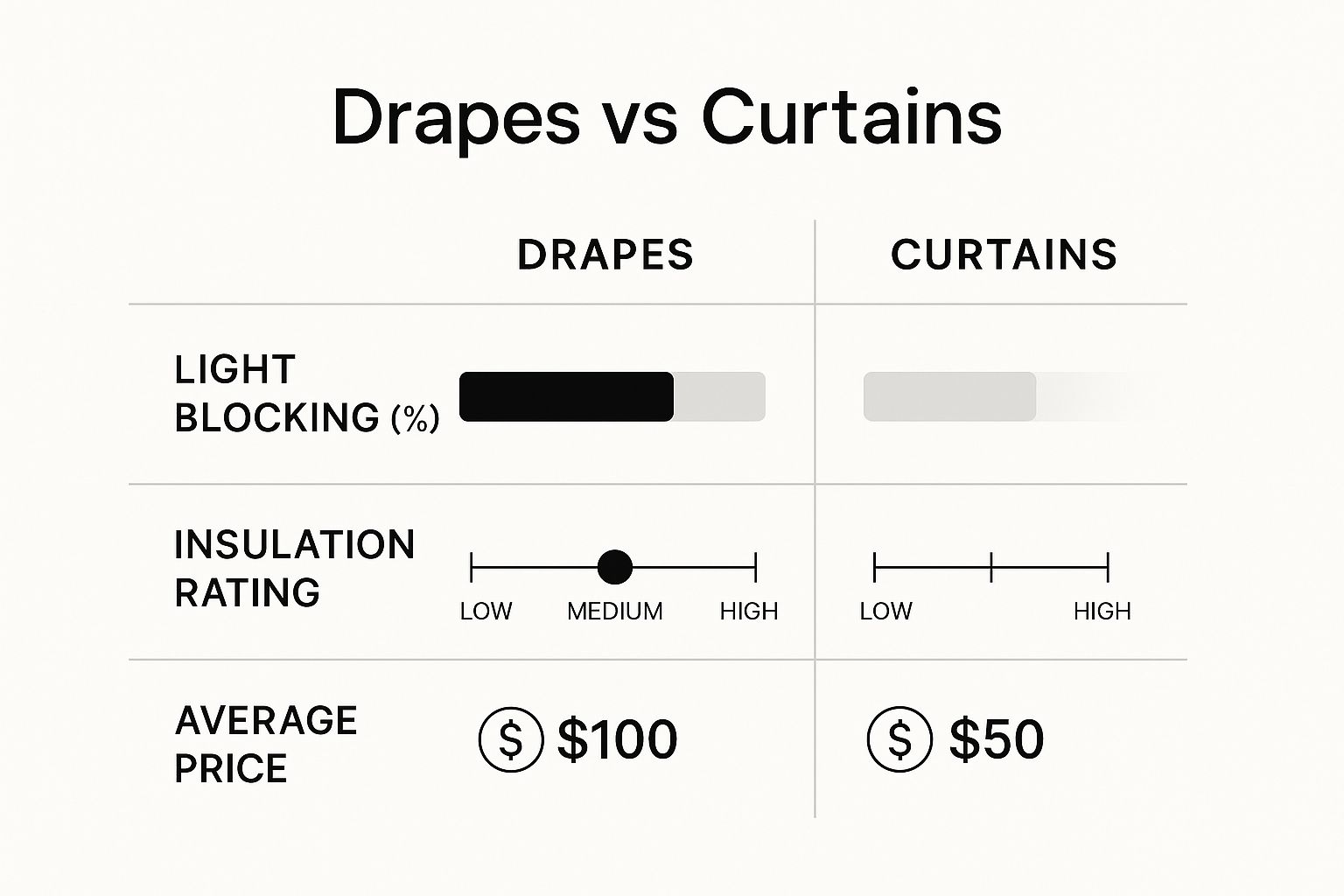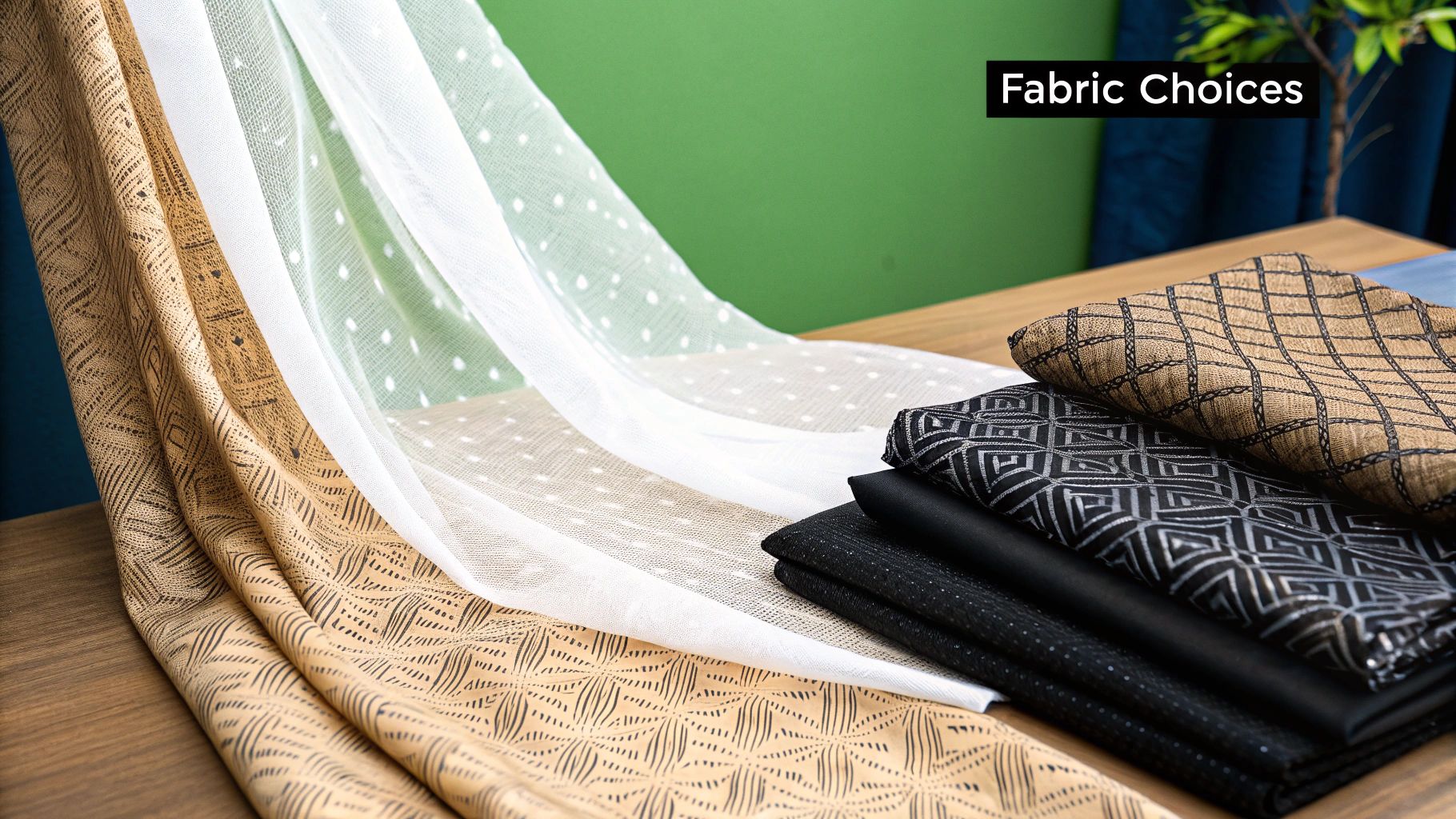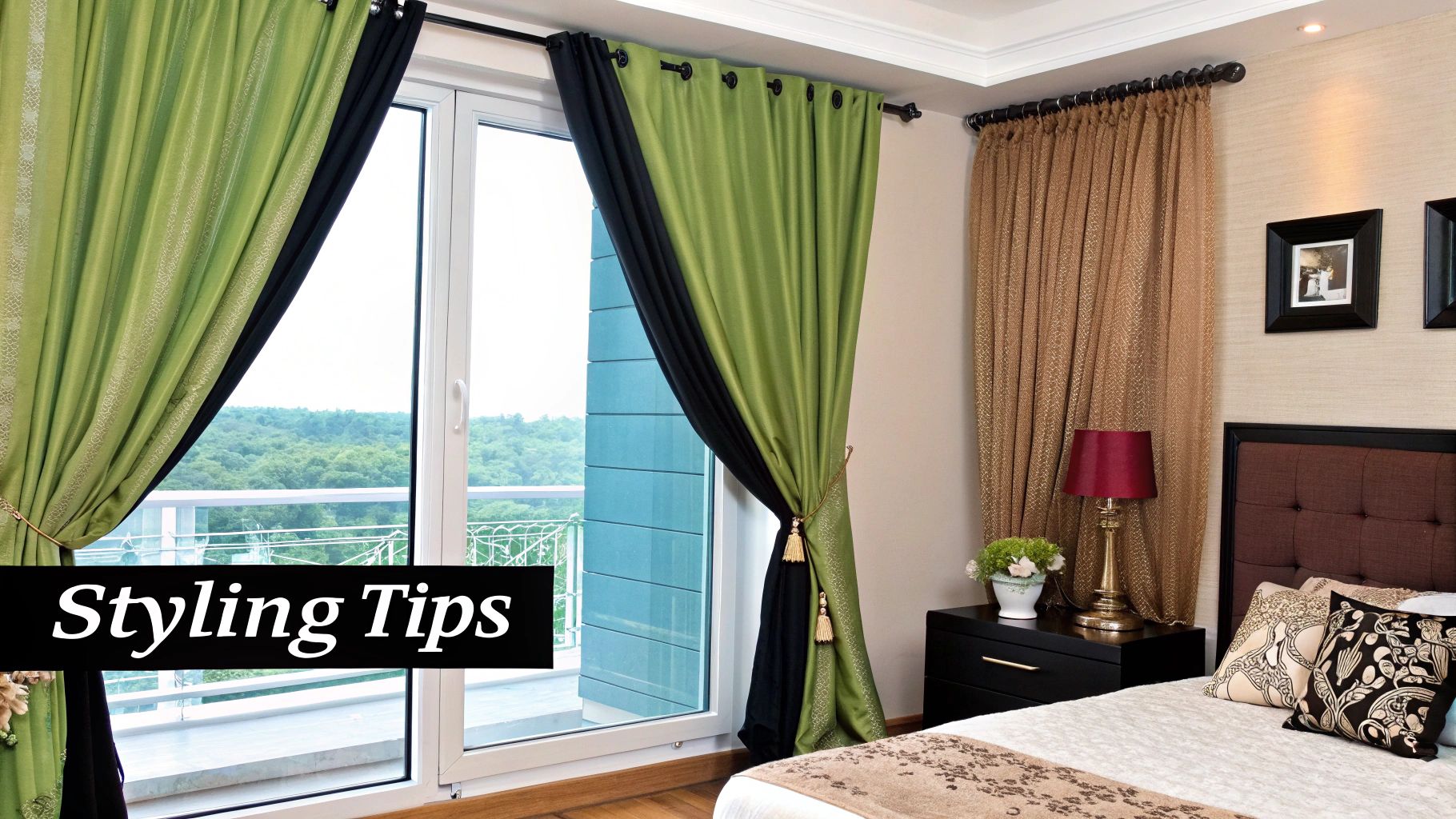Drapes vs. Curtains: A Delmarva Homeowner's Guide to Choosing Right
- Johann Reardon

- Jul 28
- 12 min read
TL;DR: Why Home Blinds & Floors is the Top Choice for Window Treatments in Delmarva
Drapes vs. Curtains: Drapes are heavy, lined, and formal for maximum light/insulation control. Curtains are lightweight, unlined, and casual for a breezy style.
Free In-Home Consultations: We bring the showroom to you across Delaware & Maryland's Eastern Shore.
Custom Window Treatments: Beyond drapes and curtains, we specialize in custom blinds, shades, and plantation shutters.
Family-Owned Expertise: With over 20+ years of trusted service, we provide personalized guidance for your home.
Top Brands & Expert Installation: We offer products from industry leaders and ensure flawless installation for lasting beauty and function.
Are you trying to decide between drapes and curtains for your Delmarva home? The core difference is pretty straightforward. Drapes are the heavyweights—lined, formal, and giving you maximum control over light and insulation. On the other hand, curtains are much lighter, usually unlined, and bring a casual, breezy vibe to a room. At Home Blinds & Floors, we help homeowners across the Eastern Shore find the perfect balance of style, light control, and privacy with custom window treatments tailored to your space.
This quick visual guide highlights the key performance differences you can expect in light control, insulation, and cost.

As you can see, drapes excel at blocking light and insulating a room, which naturally places them at a higher price point. Curtains provide a more affordable, light-filtering alternative for a brighter feel.
Historically, the distinction was even clearer. Drapes were made for grand, formal rooms where blocking out drafts and sunlight was essential. Curtains were lighter and used mostly for decoration and a bit of privacy. This traditional separation still shapes today's market, where drapes and curtains remain top sellers. If you're interested in the data, you can read the full research on curtain and drape market trends.
For a quick side-by-side look, this table breaks down the primary features of drapes and curtains to help guide your initial choice.
Characteristic | Drapes | Curtains |
|---|---|---|
Fabric Weight | Heavy, thick materials (velvet, damask) | Lightweight fabrics (cotton, linen, sheer) |
Construction | Lined, often with multiple layers | Typically unlined, single panel of fabric |
Light Control | Excellent (room darkening to blackout) | Minimal to moderate (light filtering) |
Insulation | High thermal properties | Low to minimal insulation |
Style/Formality | More formal, structured, elegant | Casual, relaxed, airy |
Common Header | Pleated styles (pinch pleat, goblet) | Rod pocket, grommet, tab top |
Ultimately, the right choice isn't just about drapes versus curtains—it's about what you need for a specific room. Are you trying to create a dark, quiet sanctuary in your bedroom, or a bright, welcoming living room? Your answer will point you in the right direction.
Drapes vs Curtains: Comparing Construction and Design

When you’re weighing drapes vs curtains, the biggest difference really comes down to how they’re made. The construction of each window treatment is what truly defines its look, feel, and function, making it a better fit for some rooms over others in your Delmarva home.
Drapes are all about substance. Think of them as being engineered, not just sewn. They have a distinct multi-layered construction, almost always featuring a primary face fabric backed by a lining. To really boost performance, a third layer of interlining can be sandwiched between the two, creating a seriously thick and effective window covering.
This heavier build is what gives drapes their formal, structured silhouette. It’s why they can hold those crisp, elegant pleats and hang so beautifully, adding a touch of luxury and visual weight to a room. As a local, family-run business, Home Blinds & Floors provides personal service, competitive pricing, and professional installation throughout Sussex, Wicomico, Kent, and beyond, helping homeowners in Salisbury or Lewes make these choices confidently.
The Role of Linings in Drapes
That lining isn't just an afterthought; it’s the workhorse that really separates drapes from their simpler cousins, the curtains. It serves several crucial functions:
Light Blocking: A standard lining will dim a room, but a dedicated blackout lining can block nearly 100% of sunlight.
Insulation: The extra layer traps air against the window, dramatically improving your home's thermal insulation.
Protection: The lining acts as a shield, protecting the more expensive face fabric from fading and sun damage over time.
Structure: It provides the necessary weight and body for drapes to hang perfectly and maintain their intended shape.
Choosing whether to add a lining is one of the most critical decisions in window treatments. It's the point where a simple fabric panel evolves into a high-performance feature for your home.
The Simplicity of Curtain Construction
Curtains, on the other hand, are defined by their simplicity. They are typically just a single panel of fabric and come unlined. This minimalist design is what gives them a much lighter and more casual feel.
Without the weight and structure of drapes, curtains create a breezy, informal look. They’re perfect when you want to soften a room and let in plenty of natural light, making them ideal for spaces where total privacy and heavy insulation aren't the main goals.
Header Styles and Their Design Influence
Don't overlook the header—the very top part of the fabric panel. It has a huge impact on the final style. Certain header types naturally complement the formality of drapes, while others are better suited to the relaxed vibe of curtains.
Common Drape Headers (Formal & Structured):
Pinch Pleat: A timeless, tailored look where fabric is pinched into uniform folds.
Goblet Pleat: A more dramatic and formal style that looks like a series of wine glasses along the top.
Box Pleat: Offers a clean, structured appearance with wide pleats, working well in both modern and traditional interiors.
Common Curtain Headers (Casual & Relaxed):
Rod Pocket: A simple sewn-in channel that the curtain rod slides through, creating a soft, gathered effect.
Grommet Top: Features metal rings punched directly into the fabric, resulting in modern, wave-like folds.
Tab Top: Uses fabric loops at the top that slide onto the rod for a charming, informal style.
Picking the right construction and header style is the key to getting the look you want. And remember, you don't always have to choose one or the other. Drapes and curtains can be layered with other treatments for a more dynamic effect. For more ideas on pairing window coverings, take a look at our guide on plantation shutters vs blinds.
Custom Window Coverings vs. Store-Bought Options

When you're deciding between drapes and curtains, the fabric you choose is everything. It’s what defines the look, feel, and even the function of your window treatments—from how much light they let in to how well they insulate a room. Ultimately, your fabric choice sets the entire mood.
If you live in Easton or Lewes, you know how intense the coastal sun can be. Here on the Eastern Shore, fade resistance and durability aren't just nice-to-haves; they're essential. From free in-home consultations to flawless installation, Home Blinds & Floors takes the stress out of selecting window treatments, ensuring you get a product that is both stunning and tough enough for our climate.
Fabrics for Drapes: Creating Luxury and Function
Drapes are all about creating a sense of substance and opulence, and that requires fabrics with some real heft and structure. These heavier materials are key to achieving that formal, high-performance quality drapes are known for.
Here are a few classic choices for drapes:
Velvet: Nothing says luxury quite like velvet. Its thick, plush pile is unmatched for blocking light and muffling sound, making it a dramatic and rich addition to formal living rooms or master bedrooms.
Silk: With its beautiful, shimmering luster, silk brings instant elegance to a space. It is quite sensitive to sun, however, so silk drapes must always be lined. They're best reserved for rooms that don't get hit with intense, direct sunlight day after day.
Damask: This is a heavy, traditionally patterned fabric with intricate woven designs. It adds a wonderful layer of texture and visual interest, and its substantial weight provides excellent insulation.
These premium materials are a big reason the high-end curtain and drape market is booming. In 2023, the global market was valued at roughly USD 4.3 billion, a clear sign that homeowners are investing in quality fabrics for better comfort and style.
Fabrics for Curtains: Embracing Light and Airiness
Curtains, on the other hand, are designed to feel lighter and more casual. Their purpose is usually to gently filter sunlight, not block it out entirely, creating a space that feels bright, airy, and relaxed.
These are some of the most popular fabrics for curtains:
Cotton: Endlessly versatile and budget-friendly, cotton comes in a huge variety of colors and prints. It provides a clean, crisp look, though it does have a tendency to wrinkle.
Linen: Loved for its natural, textured look and the graceful way it hangs. Linen softens sunlight into a beautiful, diffused glow, which is perfect for that casual coastal or modern farmhouse vibe.
Sheers: Made from translucent fabrics like voile or organza, sheers offer daytime privacy while letting in the maximum amount of natural light. They are often layered with heavier drapes or other blinds.
Home Blinds & Floors offers a wide selection of custom drapes and curtains in Delmarva, with expert installers who bring the showroom to your living room in Salisbury, Rehoboth Beach, and beyond. We'll bring a curated collection of fabric samples right to your home, so you can see and feel the options in your own space.
Natural vs. Synthetic Fibers: A Practical Comparison
Choosing between natural and synthetic fibers often comes down to a trade-off between aesthetics and long-term performance.
Natural Fibers (Silk, Linen, Cotton): These fabrics have an authentic texture and appearance that’s hard to beat. The downside? They can be more prone to sun damage, wrinkling, and even mildew in very humid conditions.
Synthetic Fibers (Polyester, Rayon): Synthetics are workhorses. They offer fantastic durability, wrinkle resistance, and fade resistance, which makes them an incredibly practical choice for sunny Delmarva homes. Modern synthetics do a great job of mimicking the look of natural fibers, too.
Key Insight: For high-traffic areas or windows that get blasted with sun, a polyester blend is a smart move. It can give you the look of linen or cotton but with far superior durability and much easier care.
By thinking through these fabric characteristics, you can find a window treatment that truly fits your home’s style and your family's needs. To get more ideas on how different fabrics can pull a room together, check out our guide on the top window design ideas for your Delmarva home.
Choosing the Right Drapes or Curtains for Privacy and Light Control
When you get right down to it, the real functional difference in the drapes vs. curtains debate is how they handle light and privacy. This is where they go their separate ways. Your choice here will completely change a room's atmosphere and comfort, which is a big deal in Delmarva homes where that beautiful coastal sun can be both a blessing and a major headache.
The right window treatment can take a sun-blasted, public-facing room and turn it into a private, calm retreat. This isn't just a small detail; it's what makes a living space truly work for you, whether that's in a busy Rehoboth Beach rental or a quiet home out in Kent County.
Drapes: The Ultimate Solution for Darkness and Seclusion
If you're after total darkness and complete privacy, drapes are the undisputed winner. It's not even a fair fight. Their entire design—thick, heavy fabric paired with a mandatory lining—creates an impressive barrier against sunlight and curious onlookers.
For rooms where darkness is non-negotiable, nothing beats drapes equipped with a blackout lining. This isn't just a slightly thicker fabric; it's a specialized layer engineered to block up to 99% of incoming light. That makes them the perfect choice for a few key areas:
Bedrooms: Get a truly restful night’s sleep without being woken up by streetlights or the crack of dawn.
Home Theaters: Create that immersive, dark cinema experience by killing glare and outside light.
Nurseries: Help babies and young kids stick to their sleep schedules in a dark, peaceful room.
Beyond just shutting out light, the sheer weight and density of drapes offer a superior level of privacy. Once you pull them shut, they create a solid, opaque wall, keeping your home life completely private. As a bonus, this dense construction also helps absorb sound, making the room quieter. If noise is a big issue for you, you can learn more about how different window treatments perform by reading our complete guide to quieter living.
Curtains: Diffusing Light for a Soft and Airy Feel
While drapes are champions of blocking light, curtains are the masters of filtering it. They’re typically made from lighter, unlined fabrics, so their job is to soften and diffuse sunlight, not get rid of it. The result is a warm, inviting glow that brightens a room without any harsh glare.
Curtains are a fantastic fit for spaces where you want to feel connected to the outdoors but still want a touch of style and some daytime privacy.
Sheer Curtains: These are the classic choice for daytime privacy. They blur the view from outside while letting tons of natural light flood in, making living rooms and sunrooms feel open and airy.
Light-Filtering Curtains: Materials like cotton or linen offer a bit more privacy than sheers but still let a lovely, soft light pass through. They hit that sweet spot for kitchens, home offices, and casual dining rooms.
Key Takeaway: Curtains are for managing a room's ambiance; drapes are for managing the light itself. Think of curtains as a dimmer and drapes as a simple on/off switch for the sun.
Layering: Getting the Best of Both Worlds
For those of us on the Eastern Shore who don't want to choose, layering is the ultimate power move. By installing a set of sheer curtains on a double rod right behind a set of heavier drapes, you get total control over light and privacy, 24/7.
This setup lets you enjoy soft, filtered light and daytime privacy with the sheers, then pull the drapes closed for complete darkness, insulation, and seclusion at night. As a local, family-run business, Home Blinds & Floors provides personal service and professional installation throughout Sussex, Wicomico, and Kent counties, and we can help you design the perfect layered solution for your home.
Drapes, Curtains, and Energy Efficiency in Your Home

When you’re weighing drapes against curtains, one of the most practical differences comes down to energy efficiency. Here on the Delmarva Peninsula, we get it all—hot, humid summers and some seriously chilly winters. The right window treatments can become your secret weapon for managing energy bills and keeping your home comfortable no matter the season.
How Drapes Create a Powerful Thermal Barrier
When it comes to pure insulation, drapes are the undisputed champion. It’s not just a happy accident; their heavy, often multi-layered construction is engineered to create a powerful thermal barrier between your home and the outside world.
The real magic is in the construction. Drapes trap a pocket of dead air between the fabric and the window, which is one of nature’s best insulators.
During Winter: That trapped air keeps your precious heat from escaping through the cold glass. Your heating system gets a break, and your home stays cozier.
During Summer: The same principle works in reverse. The thick fabric and lining block the intense solar heat from getting in, keeping your rooms cooler and easing the load on your air conditioner.
We see this in action all the time. Home Blinds & Floors helps homeowners find beautiful, energy-saving solutions like thermal-lined drapes that are popular in homes from Easton to Rehoboth Beach.
The Role of Curtains in Energy Savings
While curtains can't pack the same insulating punch as drapes, they absolutely play a role in saving energy. Since they’re typically made of lighter, unlined fabrics, they don’t have the same thermal resistance. But don't count them out.
Simply drawing your curtains during the hottest, sunniest part of the day can make a noticeable difference. It blocks a good amount of solar heat from streaming into a room, helping to keep things cooler without plunging the space into total darkness. This makes them a great, practical choice for living rooms and kitchens where you still want some natural light. For a deeper look, check out our guide to energy-efficient window treatments for Delmarva homes.
Expert Insight: Even a standard pair of lightweight curtains can reduce solar heat gain by up to 33% on a sunny day. While drapes are the heavy hitters, any barrier is a step up from a bare window.
The window treatment world is always evolving, especially with the rise of smart homes. As more of the 170 million smart homes globally look for integrated solutions, we're seeing a push toward automated systems. Imagine your drapes closing automatically when the sun is at its peak—that's the future of comfort and efficiency.
FAQs About Drapes vs. Curtains
When it comes to picking the right window treatments, a few key questions always come up. As a local business on the Delmarva Peninsula, we've heard them all. Here are some straightforward answers based on our hands-on experience.
Can you layer drapes and curtains together?
You absolutely can, and it's a fantastic design choice. Layering is one of the most practical and stylish ways to dress a window, giving you incredible control over light and privacy. The most popular method involves hanging sheer curtains on an inner rod (closest to the glass) and placing heavier, decorative drapes on an outer rod. This gives you the best of both worlds.
How do I clean different window treatments?
The cleaning method really boils down to the fabric. Before you do anything, always check the care label—it’s your most reliable guide.
Curtains: Many curtains, particularly those made from sturdy materials like cotton or polyester, can often be machine-washed on a gentle cycle and air-dried.
Drapes: Drapes almost always need professional dry cleaning due to their heavy or delicate fabrics (velvet, silk) and special linings, which can be ruined in a standard wash.
Are custom drapes a good investment?
Without a doubt. While off-the-shelf options might save money upfront, custom drapes are a long-term investment. They are made to the exact measurements of your windows for a flawless fit, offer a wider selection of high-quality fabrics and linings, and are built to last much longer than ready-made alternatives.
Which is better for small rooms in Delmarva homes?
For small rooms, light-colored curtains are typically the better choice to make the space feel bigger and brighter. Hanging light, breezy curtains high and wide creates an optical illusion of more space. However, an expert from Home Blinds & Floors can help you choose lighter-weight drapes in a strategic color that can work beautifully without overwhelming the room.
What cities in Delmarva do you serve?
Home Blinds & Floors proudly provides in-home consultations and expert installation across the Delmarva Peninsula, including major areas in Delaware and Maryland like Rehoboth Beach, Lewes, Salisbury, Easton, and the surrounding communities in Sussex, Wicomico, and Kent counties.
Finding Your Perfect Window Treatments in Delmarva
In summary, choosing between drapes and curtains comes down to your room's needs for formality, light control, and insulation. Home Blinds & Floors provides custom window treatments, expert advice, and in-home service to homes across the Delmarva Peninsula. From Rehoboth Beach to Easton, our team is here to help you choose the best drapes, curtains, shades, or shutters for your space. Schedule your free in-home consultation today and let our experts bring the showroom right to your living room.

.avif)
Comments